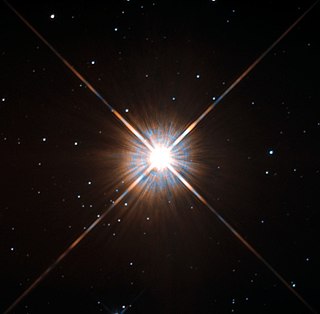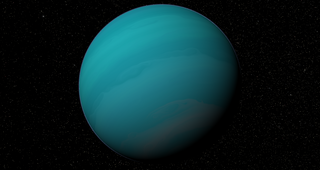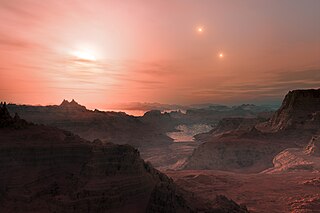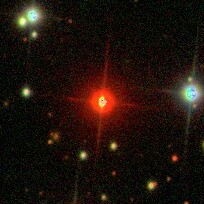Related Research Articles

A red dwarf is the smallest kind of star on the main sequence. Red dwarfs are by far the most common type of fusing star in the Milky Way, at least in the neighborhood of the Sun. However, due to their low luminosity, individual red dwarfs cannot be easily observed. From Earth, not one star that fits the stricter definitions of a red dwarf is visible to the naked eye. Proxima Centauri, the star nearest to the Sun, is a red dwarf, as are fifty of the sixty nearest stars. According to some estimates, red dwarfs make up three-quarters of the fusing stars in the Milky Way.
Gliese 581 is a red dwarf star of spectral type M3V which hosts a planetary system, 20.5 light-years away from Earth in the Libra constellation. Its estimated mass is about a third of that of the Sun, and it is the 101st closest known star system to the Sun. Gliese 581 is one of the oldest, least active M dwarfs known. Its low stellar activity improves the likelihood of its planets retaining significant atmospheres, and lessens the sterilizing impact of stellar flares.

Gliese 581b or Gl 581b is an exoplanet orbiting within the Gliese 581 system, located 20.5 light-years away from Earth in the Libra constellation. It is the first planet discovered of three confirmed in the system so far, and the second in order from the star.

Gliese 876 b is an exoplanet orbiting the red dwarf Gliese 876. It completes one orbit in approximately 61 days. Discovered in June 1998, Gliese 876 b was the first planet to be discovered orbiting a red dwarf.

A Super-Earth is a type of exoplanet with a mass higher than Earth's, but substantially below those of the Solar System's ice giants, Uranus and Neptune, which are 14.5 and 17 times Earth's, respectively. The term "super-Earth" refers only to the mass of the planet, and so does not imply anything about the surface conditions or habitability. The alternative term "gas dwarfs" may be more accurate for those at the higher end of the mass scale, although "mini-Neptunes" is a more common term.

Gliese 581e or Gl 581e is an exoplanet orbiting within the Gliese 581 system, located 20.5 light-years away from Earth in the Libra constellation. It is the third planet discovered in the system and the first in order from the star.

An exoplanet is a planet located outside the Solar System. The first evidence of an exoplanet was noted as early as 1917, but was not recognized as such until 2016; no planet discovery has yet come from that evidence. What turned out to be the first detection of an exoplanet was published among a list of possible candidates in 1988, though not confirmed until 2003. The first confirmed detection came in 1992, with the discovery of terrestrial-mass planets orbiting the pulsar PSR B1257+12. The first confirmation of an exoplanet orbiting a main-sequence star was made in 1995, when a giant planet was found in a four-day orbit around the nearby star 51 Pegasi. Some exoplanets have been imaged directly by telescopes, but the vast majority have been detected through indirect methods, such as the transit method and the radial-velocity method. As of 1 July 2024, there are 6,660 confirmed exoplanets in 4,868 planetary systems, with 995 systems having more than one planet. This is a list of the most notable discoveries.

Gliese 667 Cc is an exoplanet orbiting within the habitable zone of the red dwarf star Gliese 667 C, which is a member of the Gliese 667 triple star system, approximately 23.62 light-years away in the constellation of Scorpius. The exoplanet was found by using the radial velocity method, from radial-velocity measurements via observation of Doppler shifts in the spectrum of the planet's parent star.
Kepler-61b is a super-Earth exoplanet orbiting within parts of the habitable zone of the K-type main-sequence star Kepler-61. It is located about 1,100 light-years from Earth in the constellation of Cygnus. It was discovered in 2013 using the transit method, in which the dimming effect that a planet causes as it crosses in front of its star is measured, by NASA's Kepler spacecraft.
Gliese 180, is a small red dwarf star in the equatorial constellation of Eridanus. It is invisible to the naked eye with an apparent visual magnitude of 10.9. The star is located at a distance of 39 light years from the Sun based on parallax, and is drifting closer with a radial velocity of −14.6 km/s. It has a high proper motion, traversing the sky at the rate of 0.765 arcseconds per year.

Wolf 1061 c is an exoplanet orbiting within the habitable zone of the red dwarf star Wolf 1061 in the constellation Ophiuchus, about 14.1 light-years from Earth. At the time of discovery, it was the closest known potentially habitable exoplanet to Earth, though several closer ones have since been found. It is the second planet in order from its host star in a triple planetary system, and has an orbital period of 17.9 days. Wolf 1061 c is classified as a super-Earth exoplanet as its mass is between that of Earth and the ice giants.
Luyten b is a confirmed exoplanet, likely rocky, orbiting within the habitable zone of the nearby red dwarf Luyten's Star. It is the fourth-closest potentially habitable exoplanet known, at a distance of 12 light-years. Only Proxima Centauri b, Ross 128 b, and GJ 1061 d are closer. Discovered alongside Gliese 273c in June 2017, Luyten b is a super-Earth of around 2.89 times the mass of Earth and receives only 6% more starlight than Earth, making it one of the best candidates for habitability.

Teegarden's Star b is an exoplanet found orbiting within the habitable zone of Teegarden's Star, an M-type red dwarf 12.5 light years away from the Solar System. It had the highest Earth Similarity Index (ESI) of any exoplanet, but in February 2024 a new study updated the parameters of the planet, thus reducing its ESI to 0.90, making it no longer the planet with the hightest ESI. Along with Teegarden's Star c, it is among the closest known potentially habitable exoplanets.
Teegarden's Star c is an exoplanet found orbiting in the habitable zone of Teegarden's Star, an M-type red dwarf star 12.5 light years away from the Solar System. It orbits in the conservative habitable zone around its star. Along with Teegarden's Star b, it is among the closest known potentially habitable exoplanets. It was discovered in June 2019.

Habitability of G V stars of G V stars systems defines the suitability for life of exoplanets belonging to yellow dwarf stars. These systems are the object of study among the scientific community because they are considered the most suitable for harboring living organisms, together with those belonging to K-type stars.

Wolf 1069 is a red dwarf star located 31.2 light-years away from the Solar System in the constellation of Cygnus. The star has 17% the mass and 18% the radius of the Sun, a temperature of 3,158 K, and a slow rotation period of 150–170 days. It hosts one known exoplanet called Wolf 1069 b which could possibly sustain life.

Gliese 414 Ac, or GJ 414 Ac, is an exoplanet orbiting Gliese 414 A, a K-type main-sequence star located 39 light-years from Earth, in the constellation Ursa Major. It is classified as a super-Neptune exoplanet, being at least 54 times more massive than the Earth and about 8.5 times larger. Gliese 414 Ac orbits its parent star at a distance of 1.4 astronomical units and completes one revolution around it every 2 years and 20 days. It is one of the two planets orbiting Gliese 414 A, the another is Gliese 414 Ab, a sub-Neptune.
GJ 3929 b is a confirmed exoplanet located 52 light-years away orbiting the red dwarf star GJ 3929. It is an Earth-sized planet, having a radius only 9% larger than that of Earth. It orbits its star at a distance of 0.0252 astronomical units (3,770,000 km), being located in the Venus zone of its star, and completes one orbit around it every 2 days and 15 hours. Because of the proximity of its star, and its low mass, GJ 3929 b is classified as a Venus-like planet, having an equilibrium temperature of around 300 °C and receiving planetary insolation 17 times more intense than Earth receives from the Sun.

GJ 3929, also known as Gliese 3929 and TOI-2013, is a red dwarf star located 51.6 light-years from Earth, in the constellation Corona Borealis. With an apparent magnitude of 12, it is not visible to the naked eye. In 2022, two exoplanets were detected orbiting the star.
References
- 1 2 3 4 5 6 7 8 9 10 11 12 13 14 Kossakowski, D.; Kürster, M.; Trifonov, T.; Henning, Th; Kemmer, J.; Caballero, J. A.; Burn, R.; Sabotta, S.; Crouse, J. S.; Fauchez, T. J.; Nagel, E.; Kaminski, A.; Herrero, E.; Rodríguez, E.; González-Álvarez, E. (2023-02-01). "The CARMENES search for exoplanets around M dwarfs - Wolf 1069 b: Earth-mass planet in the habitable zone of a nearby, very low-mass star". Astronomy & Astrophysics. 670: A84. arXiv: 2301.02477 . doi:10.1051/0004-6361/202245322. ISSN 0004-6361.
- 1 2 Martin, Pierre-Yves (2023). "Planet Wolf 1069 b". exoplanet.eu. Retrieved 2024-01-19.
- 1 2 3 "Wolf 1069 | NASA Exoplanet Archive". exoplanetarchive.ipac.caltech.edu. Retrieved 2024-01-19.
- ↑ "⬤ Exoplanet Gliese 1253 b". Stellar Catalog. Retrieved 2024-01-19.
- 1 2 3 4 5 6 7 8 Anderson, Natali (2023-02-08). "Astronomers Discover Earth-Mass Exoplanet in Habitable Zone of Wolf 1069". Sci.News: Breaking Science News. Retrieved 2024-01-19.
- 1 2 3 Tognetti, Laurence (February 3, 2023). "Astronomers discover potential habitable exoplanet only 31 light-years from Earth". Space.com. Retrieved 2024-01-19.
- 1 2 Carter, Jamie. "Found: An Earth-Mass Planet That's Potentially Habitable And Just 31 Light-Years Away". Forbes. Retrieved 2024-01-19.
- ↑ "Sun Fact Sheet". nssdc.gsfc.nasa.gov. Retrieved January 19, 2023.